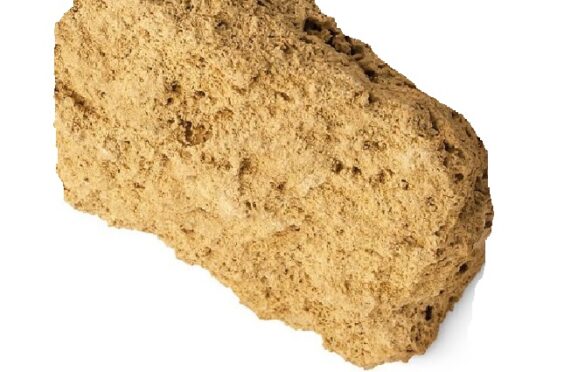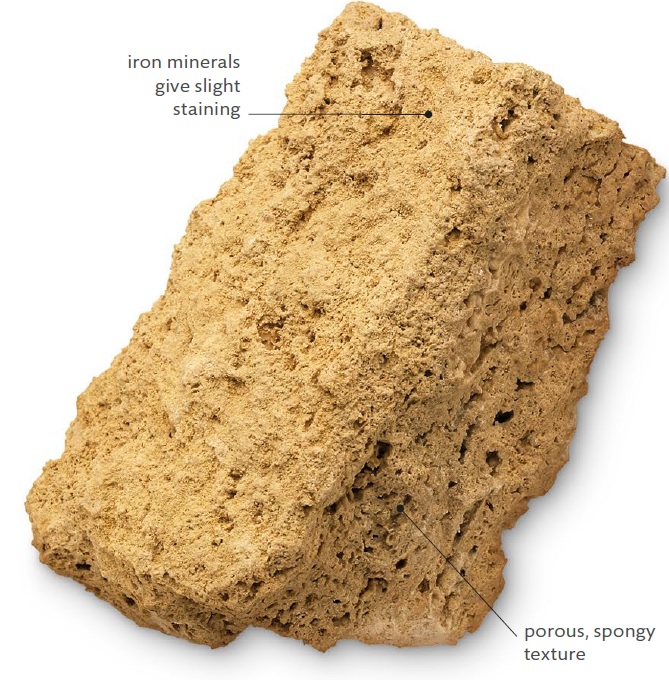
Travertine rock, a captivating sedimentary formation, stands as a testament to the intricate processes shaping our planet’s geology. This comprehensive guide unveils the mysteries of travertine, delving into its composition, texture, origin, and unique characteristics. Join us on a journey through the fascinating world of travertine as we unravel its geological marvels.
Travertine is a sedimentary rock primarily composed of almost pure calcium carbonate, showcasing its remarkable purity. Additionally, it may contain traces of detrital quartz and clay, with fossil materials being virtually absent from its formation. The rock’s coloration varies, presenting a very light shade unless influenced by iron compounds or other impurities, resulting in darker hues. Notably, travertine deposits often exhibit rounded formations and distinctive banding patterns.

Travertine’s unique texture arises from small crystals of calcite binding together various sediment particles. This amalgamation creates a cohesive structure, contributing to the rock’s strength and resilience. Often occurring in strata, the texture of travertine reflects its intricate formation process.
The genesis of travertine is closely tied to the presence of hot springs, particularly in volcanic regions. The deposition of calcium carbonate, a key component of travertine, occurs as a result of specific geological conditions. Exploring the origin of travertine unveils its connection to continental settings, with volcanic activity playing a pivotal role.
Travertine falls under the category of sedimentary rocks, highlighting its formation through the accumulation and cementation of mineral and organic particles. This classification provides insights into the rock’s environmental context and the processes that shaped it over time.
As a continental rock, travertine’s presence and formation are closely linked to terrestrial environments. Understanding its continental origin enhances our appreciation for the diverse geological settings where travertine can be found.
The fine grain size of travertine contributes to its smooth texture and compact structure. Examining the grain size helps geologists decipher the rock’s history and the conditions under which it was formed.
Travertine’s classification as a chemical sedimentary rock emphasizes the significance of chemical processes in its formation. The intricate interplay of minerals and compounds gives rise to the distinctive properties that define travertine.
While fossils are integral to the study of many sedimentary rocks, travertine stands out with its rarity in fossil content. This absence contributes to the unique characteristics of travertine and distinguishes it from other formations.
The angular grain shape of travertine provides additional clues about its geological journey. Examining the grain shape allows geologists to infer the transport and deposition mechanisms that shaped the rock.
Travertine’s versatility extends beyond its geological significance; its aesthetic appeal has made it a sought-after material in architecture and design. The distinct patterns and colors resulting from mineral impurities add a touch of natural elegance to diverse applications.
In conclusion, the exploration of travertine rock takes us on a captivating journey through its composition, texture, origin, and geological classification. From the fine crystals of calcite binding sediment particles to its formation in continental settings, travertine stands as a testament to the Earth’s dynamic processes. As we unravel the intricate details of this sedimentary marvel, we gain a deeper appreciation for the wonders written in the layers of travertine rock.
| Cookie | Duration | Description |
|---|---|---|
| cookielawinfo-checkbox-analytics | 11 months | This cookie is set by GDPR Cookie Consent plugin. The cookie is used to store the user consent for the cookies in the category "Analytics". |
| cookielawinfo-checkbox-functional | 11 months | The cookie is set by GDPR cookie consent to record the user consent for the cookies in the category "Functional". |
| cookielawinfo-checkbox-necessary | 11 months | This cookie is set by GDPR Cookie Consent plugin. The cookies is used to store the user consent for the cookies in the category "Necessary". |
| cookielawinfo-checkbox-others | 11 months | This cookie is set by GDPR Cookie Consent plugin. The cookie is used to store the user consent for the cookies in the category "Other. |
| cookielawinfo-checkbox-performance | 11 months | This cookie is set by GDPR Cookie Consent plugin. The cookie is used to store the user consent for the cookies in the category "Performance". |
| viewed_cookie_policy | 11 months | The cookie is set by the GDPR Cookie Consent plugin and is used to store whether or not user has consented to the use of cookies. It does not store any personal data. |